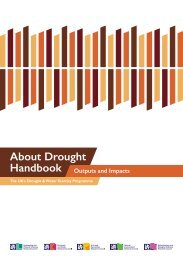DelegatePack_DroughtConference_20-21March2019
Create successful ePaper yourself
Turn your PDF publications into a flip-book with our unique Google optimized e-Paper software.
Posters<br />
Peter Cook, Emily Black & Anne Verhoef University of Reading<br />
Variations in the West African Monsoon from reanalysis and model results<br />
Rainfall in West Africa is strongly seasonal and since at present many people have no other water for irrigation it is<br />
important to understand the variations in the monsoon. Large interannual and decadal variations in the amount of<br />
rainfall are seen in ERA-Interim reanalysis, and in the results from the Met Office Unified Model (GA3) ensemble of<br />
high resolution atmosphere-only model runs with the JULES land-surface scheme and OSTIA sea-surface temperatures<br />
(UPSCALE). This work is part of BRAVE2, "building understanding of climate variability into planning of groundwater<br />
supplies from low storage aquifers in Africa (second phase)", funded under the NERC/DFID/ESRG Unlocking the<br />
Potential of Groundwater for the Poor (UPGro) program.<br />
John Bloomfield & Matthew Ascott British Geological Survey<br />
Understanding the impact of climate change on borehole yields from fractured aquifers<br />
This is essential for future water resources planning and management. Although the impact of changes in hydraulic<br />
conductivity with depth (VKD) on groundwater levels is well established, the relative significance of climate change and<br />
VKD on borehole yield estimates is poorly understood. We hypothesize that VKD exerts a significant additional<br />
control on borehole yields under climate change which has not been considered in yield assessments to date. We<br />
developed a radial groundwater flow model of an idealised pumping borehole in the fractured Chalk aquifer of southeast<br />
England, and applied 11 VKD profiles based on a simple conceptual representation of variability in hydraulic<br />
conductivity with depth in the Chalk. For each VKD profile, we applied <strong>20</strong> climate scenarios and six constant pumping<br />
rates for the period 1962 – <strong>20</strong>14. We then estimated borehole yields based on the derived lowest pumping water<br />
levels during key drought years (e.g. 1976). We show that VKD is more significant than changes in climate in<br />
controlling lowest pumping groundwater levels. Hydraulic conductivity is as significant a control as climate on borehole<br />
yields, although responses are highly non-linear associated with pumping water level-pumping rate curves intersecting<br />
key yield constraints (e.g. pump intake depth, major inflow horizons). It is recommended that variations in hydraulic<br />
conductivity with depth are taken into consideration in future assessments of borehole yields under climate change.<br />
The approach presented is generic and can be applied across different aquifers where vertical heterogeneity is present.<br />
Catherine Grasham University of Oxford<br />
A transdisciplinary approach to understanding drought risks in the Awash River basin,<br />
Ethiopia<br />
The Awash River basin in Ethiopia is of high economic importance in the country, with productive activities<br />
contributing around 30 percent to national GDP. Population growth, urbanisation, irrigation expansion and emerging<br />
industries are putting pressure on the quality and quantity of available water resources. Drought and flood events are<br />
endemic and their management is critical for mitigating water risks and achieving sustainable development. This<br />
research paper offers a transdisciplinary approach to a more holistic understanding of drought risks. Previous research<br />
has used global, regional and basin scale hydro-climatic models to inform decision-making around optimum investments<br />
for drought management. However, these analyses have often overlooked the varying benefits to different water users<br />
(domestic, irrigated agriculture, rainfed agriculture, industry, livestock). This research co-produces knowledge across<br />
disciplines using basin scale climate hazard mapping, water resources modelling and risk perspectives from interviews<br />
and discussions with different water users at the woreda (district) level. We find that risk is not homogenous and<br />
consists of social, economic and cultural dimensions. The adaptive capacity of water users is influenced by water<br />
source, access to water technologies and position in the basin. Water users utilising groundwater were found to be<br />
more resilient and industries with sophisticated water pumping technologies experienced less impact on production<br />
during a drought year. Attempts to mitigate risks upstream were exacerbating negative impacts on downstream<br />
groups. We have found that a transdisciplinary research design allows drought risk thresholds to be developed for<br />
different water users, which is necessary to support equitable water management outcomes. Our findings are<br />
particularly relevant for decisions makers concerned with ensuring that investments to mitigate drought risks benefit<br />
the poor.




